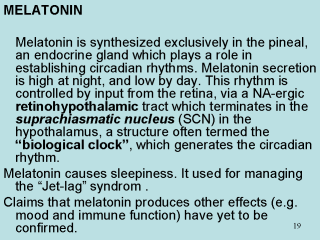| front |1 |2 |3 |4 |5 |6 |7 |8 |9 |10 |11 |12 |13 |14 |15 |16 |17 |18 |19 |20 |21 |22 |23 |24 |25 |26 |27 |28 |review |
 |
NITRIC OXIDE
Nitric oxide (NO) is a peripheral
mediator. Its significance as an important chemical mediator in CNS
became apparent only about 10 years ago.
NO in nervous system is produced
mainly by constitutive neuronal form of nitric oxide synthase (nNOS).
It is present in roughly 2% of neurons, both short interneurons and
long-tract neurons, in virtually all brain areas, with particular
concentration in cerebellum and hippocampus. It occurs in cell bodies
and dendrites, as well as in axon terminals, suggesting that the
release of NO is not
restrict to conventional
neurotransmitter release sites. nNOS is calmodulin-dependent .
NO exerts its effects in two main
ways:
by
activation of soluble guanylate cyclase, leading to the
production of cGMP, leading to various phosphorilation cascades. This
“physiological” control mechanism operates at low NO concentration
of about 0,1 μM/l.
by reacting with superoxide free
radical, to generate peroxynitrite, a highly toxic anion, which acts
by oxidizing various intracellular proteins. This requires
concentration of 1- 10μM/l,
which are achieved in brain ischemia.
There is good evidence that NO plays
a role in long-term potentiation and depression.
NO is also believed to play an
important role in the mechanisms by which ischemia causes neuronal
death.
|
| front |1 |2 |3 |4 |5 |6 |7 |8 |9 |10 |11 |12 |13 |14 |15 |16 |17 |18 |19 |20 |21 |22 |23 |24 |25 |26 |27 |28 |review |